The Influence of Local Climatic Factors and Water Vapor Transport from North Atlantic Ocean on Winter Snow-Cover Variation on Western Kunlun Mountains and Eastern Pamir Plateau
Abstract
1. Introduction
2. Methods and Materials
2.1. The Western Kunlun Mountain and Eastern Pamir Plateau
2.2. Data Sources
2.3. The Whole Layer Water Vapor Flux and Related Vectors
2.4. The FLEXPART Model
2.5. Trend Calculation and Significance Assessment
3. Results
3.1. Spatiotemporal Characteristics of the SCD on the KMPP
3.2. Effects of the Temperature and Precipitation on the Increasing SCD on the KMPP
3.3. Correlation Between Global SST and KMPP SCD
3.4. The Influence of Water Vapor Transport in the Northern North Atlantic Ocean on the KMPP SCD
3.5. Simulation of the Water VAPOR Transport Influence from the Northern North Atlantic Ocean
4. Discussion
4.1. The Representativeness of SCD Data
4.2. Changes in SCD on the TP and KMPP
4.3. Causes and Impacts of SCD Changes on the KMPP
4.4. Limitations
5. Conclusions
- (1)
- From 1989 to 2020, SCD increased significantly, with the trend of 4.75 days/decade (significant at the 0.01 level), in winter on the KMPP, while that of the TP decreased significantly at −1.50 days/decade (significant at the 0.1 level). This confirms previous research findings that SCD on the KMPP have not decreased, but show a significant increase that differs from that on the TP region. Additionally, using more comprehensive variational SCD data, we found that SCD on the KMPP continue to increase, which is consistent with trends in areas with dense station coverage. This highlights the uncertainty of relying on sparse station data and the need for high resolution remote sensing and station data to better assess SCD trends, particularly on the KMPP.
- (2)
- The variation of SCD results from the combined effect of local temperature and local precipitation. On the KMPP, there is an increasing trend of precipitation, derived from ERA5, GPCP, and station data, while a decreasing trend is clear on the TP. The relative contributions of precipitation to SCD play a dominant role on the KMPP. Increasing precipitation is the local influencing factor for the abnormal increase of SCD in winter on the KMPP. This is clearly different from the reasons for SCD changes on the TP, where the decrease in SCD is attributed to a combination of temperature and precipitation changes.
- (3)
- The correlation vector, the anomaly fields of water vapor transport in high SCD years, and the FLEXPART model simulation all confirm that the northern North Atlantic Ocean is one of the main water vapor sources. The water vapor caused by SST warming flows out of the northern North Atlantic Ocean and then travels to the KMPP through the Iranian Plateau. Atlantic SST warming has enhanced moisture transport, increasing precipitation and SCD in winter on the KMPP. This indicates that the warming of high-latitude SST in the North Atlantic plays an important role in regulating regional differences in TP snow changes. However, this study only focuses on the impact of water vapor transport from North Atlantic SST warming on SCD increase on the KMPP, and an in-depth dynamic analysis is needed in the future.
Author Contributions
Funding
Data Availability Statement
Conflicts of Interest
References
- Li, P.; Mi, D. Distribution of snow cover in China. J. Glaciol. Geocryol. 1983, 4, 9–18. (In Chinese) [Google Scholar]
- Bamzai, A.S. Relationship between snow cover variability and Arctic oscillation index on a hierarchy of time scales. Int. J. Climatol. 2003, 23, 131–142. [Google Scholar] [CrossRef]
- Wang, C.; Wang, Z.; Cui, Y. Snow cover of China during the last 40 years: Spatial distribution and interannual variation. J. Glaciol. Geocryol. 2009, 31, 301–310. (In Chinese) [Google Scholar]
- Barnett, T.P.; Dümenil, L.; Schlese, U.; Roeckner, E.; Latif, M. The effect of Eurasian snow cover on regional and global climate variations. J. Atmos. Sci. 1989, 46, 661–686. [Google Scholar] [CrossRef]
- Brown, R.D.; Mote, P.W. The response of Northern Hemisphere snow cover to a changing climate. J. Clim. 2009, 22, 2124–2145. [Google Scholar] [CrossRef]
- Yang, M.X.; Wang, X.J.; Pang, G.J.; Wan, G.N.; Liu, Z.C. The Tibetan Plateau cryosphere: Observations and model simulations for current status and recent changes. Earth-Sci. Rev. 2019, 190, 353–369. [Google Scholar] [CrossRef]
- Huang, X.; Ma, Y.; Li, Y.; Yang, X. Spatiotemporal variation of snow cover over the Tibetan Plateau from 1980 to 2020. J. Glaciol. Geocryol. 2023, 45, 423–434. (In Chinese) [Google Scholar]
- Aichner, B.; Makhmudov, Z.; Rajabov, I.; Zhang, Q.; Pausata, F.S.; Werner, M.; Heinecke, L.; Kuessner, M.L.; Feakins, S.J.; Sachse, D.; et al. Hydroclimate in the Pamirs was driven by changes in precipitation-evaporation seasonality since the last glacial period. Geophys. Res. Lett. 2019, 46, 23. [Google Scholar] [CrossRef]
- Xu, X.; Zhao, T.; Lu, C.; Guo, Y.; Chen, B.; Liu, R.; Li, Y.; Shi, X. An important mechanism sustaining the atmospheric “water tower” over the Tibetan Plateau. Atmos. Chem. Phys. 2014, 14, 11287–11295. [Google Scholar] [CrossRef]
- Cohen, J.; Rind, D. The effect of snow cover on the climate. J. Clim. 1991, 4, 689–706. [Google Scholar] [CrossRef]
- Qian, Q.F.; Jia, X.J.; Wu, R.G. On the interdecadal change in the interannual variation in autumn snow cover over the central eastern Tibetan Plateau in the mid-1990s. J. Geophys. Res. 2020, 125, e2020JD032685. [Google Scholar] [CrossRef]
- Pu, Z.; Xu, X.L.; Salomonson, V.V. MODIS/Terra observed seasonal variations of snow cover over the Tibetan Plateau. Geophys. Res. Lett. 2007, 34, 137–161. [Google Scholar] [CrossRef]
- Li, W.; Guo, W.; Qiu, B.; Xue, Y.; Hsu, P.C.; Wei, J. Influence of Tibetan Plateau snow cover on East Asian atmospheric circulation at medium-range time scales. Nat. Commun. 2018, 9, 4243. [Google Scholar] [CrossRef] [PubMed]
- Wang, C.H.; Yang, K.; Li, Y.L.; Wu, D.; Bo, Y. Impacts of spatiotemporal anomalies of Tibetan Plateau snow cover on summer precipitation in eastern China. J. Clim. 2017, 30, 885–903. [Google Scholar] [CrossRef]
- Li, R.; Zhao, L.; Ding, Y.; Wu, T.; Xiao, Y.; Du, E.; Liu, G.; Qiao, Y. Temporal and spatial variations of the active layer along the Qinghai-Tibet Highway in a permafrost region. Chin. Sci. Bull. 2012, 57, 4609–4616. [Google Scholar] [CrossRef]
- Wu, G.; He, B.; Duan, A.; Liu, Y.; Yu, W. Formation and variation of the atmospheric heat source over the Tibetan Plateau and its climate effects. Adv. Atmos. Sci. 2017, 34, 1169–1184. [Google Scholar] [CrossRef]
- Xue, X.; Xu, X.; Zhao, R.; Cai, W. An Optimized Variational Processing Method Based on Satellite-Station Data on Snow Cover Days on the Qinghai–Tibet Plateau. Remote Sens. 2024, 16, 1427. [Google Scholar] [CrossRef]
- Deng, H.J.; Pepin, N.C.; Chen, Y.N. Changes of snow-fall under warming in the Tibetan Plateau. J. Geophys. Res. 2017, 122, 7323–7341. [Google Scholar] [CrossRef]
- Li, S.X.; Sato, T.; Nakamura, T.; Liu, X.Y.; Guo, W.K. Controlling factors of historical variation of winter Tibetan Plateau snow cover revealed by large-ensemble experiments. J. Geophys. Res. 2021, 126, e2021JD035127. [Google Scholar] [CrossRef]
- Chen, X.; An, S.; Inouye, D.W.; Schwartz, M.D. Temperature and snowfall trigger alpine vegetation green-up on the world’s roof. Glob. Change Biol. 2015, 21, 3635–3646. [Google Scholar] [CrossRef]
- Xiong, C.; Shi, J.; Cui, Y.; Peng, B. Snowmelt pattern over high-mountain asia detected from active and passive microwave remote sensing. IEEE Geosci. Remote Sens. Lett. 2017, 14, 1096–1100. [Google Scholar] [CrossRef]
- Mao, F.; Tang, S.H.; Sun, H.; Zhang, J.H. A study of dynamic change of dry and wet climate regions in the Tibetan Plateau over the last 46 years. Chin. J. Atmos. Sci. 2008, 32, 499–507. (In Chinese) [Google Scholar]
- Dong, N.; Xu, X.D.; Cai, W.Y.; Zhao, T.L.; Sun, C. Comprehensive effects of interdecadal change of sea surface temperature increase in the Indo-Pacific Ocean on the warming-wetting of the Qinghai−Tibet Plateau. Sci. Rep. 2022, 12, 22306. [Google Scholar] [CrossRef] [PubMed]
- Guo, H. Snow Phenology and Its Response to Climate in Northeastern China; Lanzhou University: Lanzhou, China, 2021. (In Chinese) [Google Scholar]
- Shaman, J.; Tziperman, E. The effect of ENSO on Tibetan Plateau snow depth: A stationary wave teleconnection mechanism and implications for the South Asian monsoons. J. Clim. 2005, 18, 2067–2079. [Google Scholar] [CrossRef]
- Wang, Z.B.; Wu, R.G.; Yang, S.; Lu, M.M. An interdecadal change in the influence of ENSO on the spring Tibetan Plateau snow-cover variability in the early 2000s. J. Clim. 2022, 35, 725–743. [Google Scholar] [CrossRef]
- Yuan, C.X.; Tozuka, T.; Miyasaka, T.; Yamagata, T. Respective influences of IOD and ENSO on the Tibetan snow cover in early winter. Clim. Dyn. 2009, 33, 509–520. [Google Scholar] [CrossRef]
- Yuan, C.X.; Tozuka, T.; Yamagata, T. IOD influence on the early winter Tibetan Plateau snow cover: Diagnostic analyses and an AGCM simulation. Clim. Dyn. 2012, 39, 1643–1660. [Google Scholar] [CrossRef]
- Ye, K.H.; Wu, R.G.; Liu, Y. Interdecadal change of Eurasian snow, surface temperature, and atmospheric circulation in the late 1980s. J. Geophys. Res. 2015, 120, 2738–2753. [Google Scholar] [CrossRef]
- Wang, Z.B.; Wu, R.G.; Zhao, P.; Yao, S.-L.; Jia, X.J. Formation of snow cover anomalies over the Tibetan Plateau in cold seasons. J. Geophys. Res. 2019, 124, 4873–4890. [Google Scholar] [CrossRef]
- Wu, J.J.; Wu, Z.W. Inter-decadal change of the spring North Atlantic Oscillation impact on the summer Pamir-Tienshan snow cover. Int. J. Climatol. 2018, 39, 629–642. [Google Scholar] [CrossRef]
- Yang, J.L. Analyses of atmospheric circulation of tropical Indian Ocean Basin mode influencing precipitation in East of Northwest China. Plateau Meteorol. 2015, 34, 700–705. (In Chinese) [Google Scholar]
- Ren, Q.; Zhou, C.Y.; He, J.H.; Cen, S.X.; Deng, M.Y. Impact of preceding Indian Ocean Sea surface temperature anomaly on water vapor content over the Tibetan Plateau moist pool in summer and its possible reason. Chin. J. Atmos. Sci. 2017, 41, 648–658. [Google Scholar] [CrossRef]
- Tang, J.; Guo, X.L.; Chang, Y.; Lu, G.X.; Qi, P. Temporospatial distribution and trends of thunderstorm, hail, gale, and heavy precipitation events over the Tibetan Plateau and associated mechanisms. J. Clim. 2021, 34, 9623–9646. [Google Scholar] [CrossRef]
- Li, L.; Zhang, R.H.; Wen, M.; Lv, J.M. Regionally different precipitation trends over the Tibetan Plateau in the warming context: A perspective of the Tibetan Plateau vortices. J. Geophys. Res. 2021, 48, 1680. [Google Scholar] [CrossRef]
- Braganza, K.; Karoly, D.J.; Hirst, A.C.; Stott, P.; Stouffer, R.J.; Tett, S.F.B. Simple indices of global climate variability and change Part II: Attribution of climate change during the twentieth century. Clim. Dyn. 2004, 22, 823–838. [Google Scholar] [CrossRef]
- Kamae, Y.; Watanabe, M.; Kimoto, M.; Shiogama, H. Summertime land–sea thermal contrast and atmospheric circulation over East Asia in a warming climate—Part I: Pastchanges and future projections. Clim. Dyn. 2014, 43, 2553–2568. [Google Scholar] [CrossRef]
- Xu, X.D.; Ma, Y.M.; Sun, C.; Wei, F.Y. Effect of energy and water circulation over Tibetan Plateau. Bull. Chin. Acad. Sci. 2019, 34, 1293–1305. [Google Scholar] [CrossRef]
- Yuan, J.C.; Li, W.H.; Deng, Y. Amplified subtropical stationary waves in boreal summer and their implications for regional water extremes. Environ. Res. Lett. 2015, 10, 104009. [Google Scholar] [CrossRef]
- Che, T.; Li, X.; Jin, R.; Armstrong, R.; Zhang, T. Snow depth derived from passive microwave remote-sensing data in China. Ann. Glaciol. 2017, 49, 145–154. [Google Scholar] [CrossRef]
- Dai, L.; Che, T.; Ding, Y.; Hao, X. Evaluation of snow cover and snow depth on the Qinghai–Tibetan Plateau derived from passive microwave remote sensing. Cryosphere 2017, 11, 1933–1948. [Google Scholar] [CrossRef]
- Qin, D.H.; Liu, S.Y.; Li, P.J. Snow cover distribution, variability, and response to climate change in western China. J. Clim. 2006, 19, 1820–1833. [Google Scholar]
- You, Q.L.; Kang, S.C.; Ren, G.Y.; Fraedrich, K.; Pepin, N.; Yan, Y.P.; Ma, L.J. Observed changes in snow depth and number of snow days in the eastern and central Tibetan Plateau. Clim. Res. 2011, 46, 171–183. [Google Scholar] [CrossRef]
- You, Q.L.; Wu, T.; Shen, L.C.; Pepin, N.; Zhang, L.; Jiang, Z.H.; Wu, Z.W.; Kang, S.C.; Aghakouchak, A. Review of snow cover variation over the Tibetan Plateau and its influence on the broad climate system. Earth-Sci. Rev. 2020, 201, 103043. [Google Scholar] [CrossRef]
- Xiao, C.D.; Qin, D.H.; Yao, T.D.; Ding, Y.J.; Liu, S.Y.; Zhao, L.; Liu, Y.J. Progress on observation of cryospheric components and climate-related studies in China. Adv. Atmos. Sci. 2008, 25, 164–180. [Google Scholar] [CrossRef]
- Huang, D.N.; Zhang, Z.; Zhang, S.S.; Xue, N.T. Characteristics of glacier movement in the eastern Pamir Plateau. Arid Land Geography 2021, 44, 1. (In Chinese) [Google Scholar]
- Sodemann, H.; Schwierz, C.; Wernli, H. Interannual variability of Greenland winter precipitation sources: Lagrangian moisture diagnostic and North Atlantic Oscillation influence. J. Geophys. Res. Atmos. 2008, 113, 8503. [Google Scholar] [CrossRef]
- Chen, B.; Xu, X.D.; Shi, X.H. Estimating the water vapor transport pathways and associated sources of water vapor for the extreme rainfall event over east of China in July 2007 using the Lagrangian method. Acta Meteorol. Sin. 2011, 69, 810–818. (In Chinese) [Google Scholar]
- Zhu, L.; Liu, R.; Wang, X.; Wang, Z.L.; Wen, J.; Zhao, Y.; Xie, Y.; Zhang, T.T. The characteristics of the water vapor transport and associated sources under abnormal precipitation conditions in the source region of the Yellow River using FLEXPART. Plateau Meteorol. 2019, 38, 484–496. (In Chinese) [Google Scholar]
- Zhang, X.; Vincent, L.A.; Hogg, W.D.; Niitsoo, A. Temperature and precipitation trends in Canada during the 20th century. Atmos.-Ocean 2000, 38, 395–429. [Google Scholar] [CrossRef]
- Sen, P.K. Estimates of the regression coefficient based on Kendall’s tau. J. Am. Stat. Assoc. 1968, 63, 1379–1389. [Google Scholar] [CrossRef]
- Jassby, A.D.; Cloern, J.E. Some Tools for Exploring Water Quality Monitoring Data. R Package Version 1.0.0. Available online: https://cran.r-project.org/package=wq (accessed on 15 July 2023).
- Luke, C.; Tyler, S.; Michael, P.B.; John, F.S.; Yeong, B.S.; Lewis, A.O.; Andrew, B.; Ulrich, K. Expanded and recently increased glacier surging in the Karakoram. Arct. Antarct. Alp. Res. 2011, 43, 503–516. [Google Scholar] [CrossRef]
- Hewitt, K. The Karakoram anomaly? Glacier expansion and the elevation effect, Karakoram Himalaya. Mt. Res. Dev. 2005, 25, 332–340. [Google Scholar] [CrossRef]
- Wang, N.L.; Yao, T.D.; Xu, B.Q.; Chen, A.A.; Wang, W.C. Spatiotemporal pattern, trend, and influence of glacier change in Tibetan Plateau and surroundings under global warming. China Acad. J. Electron. Publ. House 2019, 34, 1220–1232. [Google Scholar] [CrossRef]
- Gardelle, J.; Berthier, E.; Arnaud, Y. Slight mass gain of Karakoram glaciers in the early twenty-first century. Nat. Geosci. 2012, 5, 322–325. [Google Scholar] [CrossRef]
- Zhang, C.; Tang, Q.H.; Chen, D.L. Recent changes in the moisture source of precipitation over the Tibetan Plateau. J. Clim. 2017, 30, 1807–1819. [Google Scholar] [CrossRef]
- Liu, F.C.; Jia, X.J.; Dong, W. Changes in spring snow cover over the Eastern and Western Tibetan Plateau and their associated mechanism. Adv. Atmos. Sci. 2024, 41, 959–973. [Google Scholar] [CrossRef]
- Trenberth, K.E.; Guillemot, C.J. Evaluation of the atmospheric moisture and hydrological cycle in the NCEP/NCAR reanalyses. Clim. Dyn. 1998, 14, 213–231. [Google Scholar] [CrossRef]
- Wang, W.; Huang, X.D.; Deng, J.; Xie, H.J.; Liang, T.G. Spatio-temporal change of snow cover and its response to climate over the Tibetan Plateau based on an improved daily cloud-free snow cover product. Remote Sens. 2015, 7, 169–194. [Google Scholar] [CrossRef]
- Yao, T.; Bolch, T.; Chen, D.; Gao, J.; Immerzeel, W.; Piao, S.; Su, F.; Thompson, L.; Wada, Y.; Wang, L.; et al. The imbalance of the Asian water tower. Nat. Rev. Earth Environ. 2022, 3, 618–632. [Google Scholar] [CrossRef]
- Walter, W.I.; Ludovicus, P.H.V.; Marc, F.P.B. Climate change will affect the Asian Water Towers. Science 2010, 328, 1382. [Google Scholar] [CrossRef]
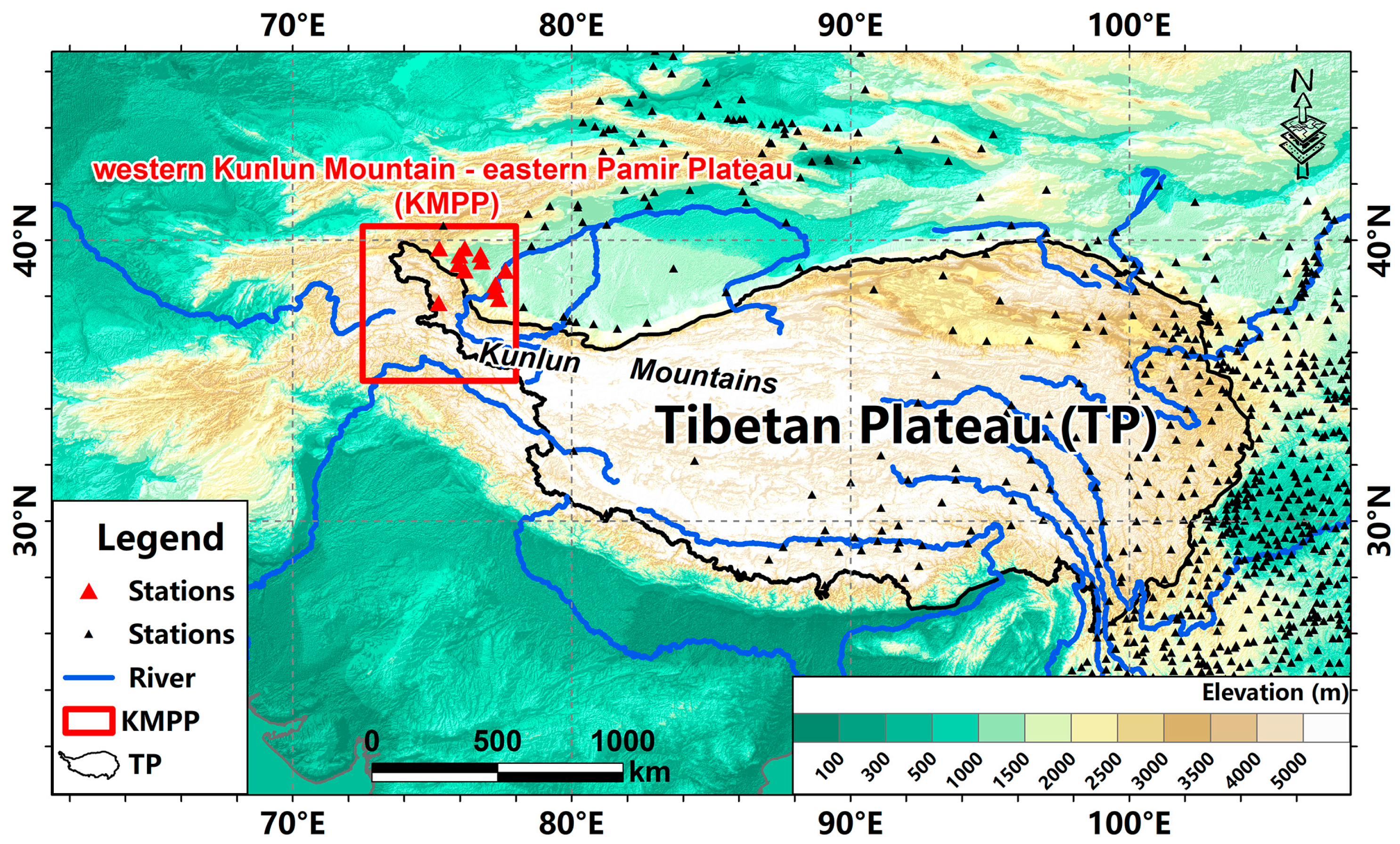
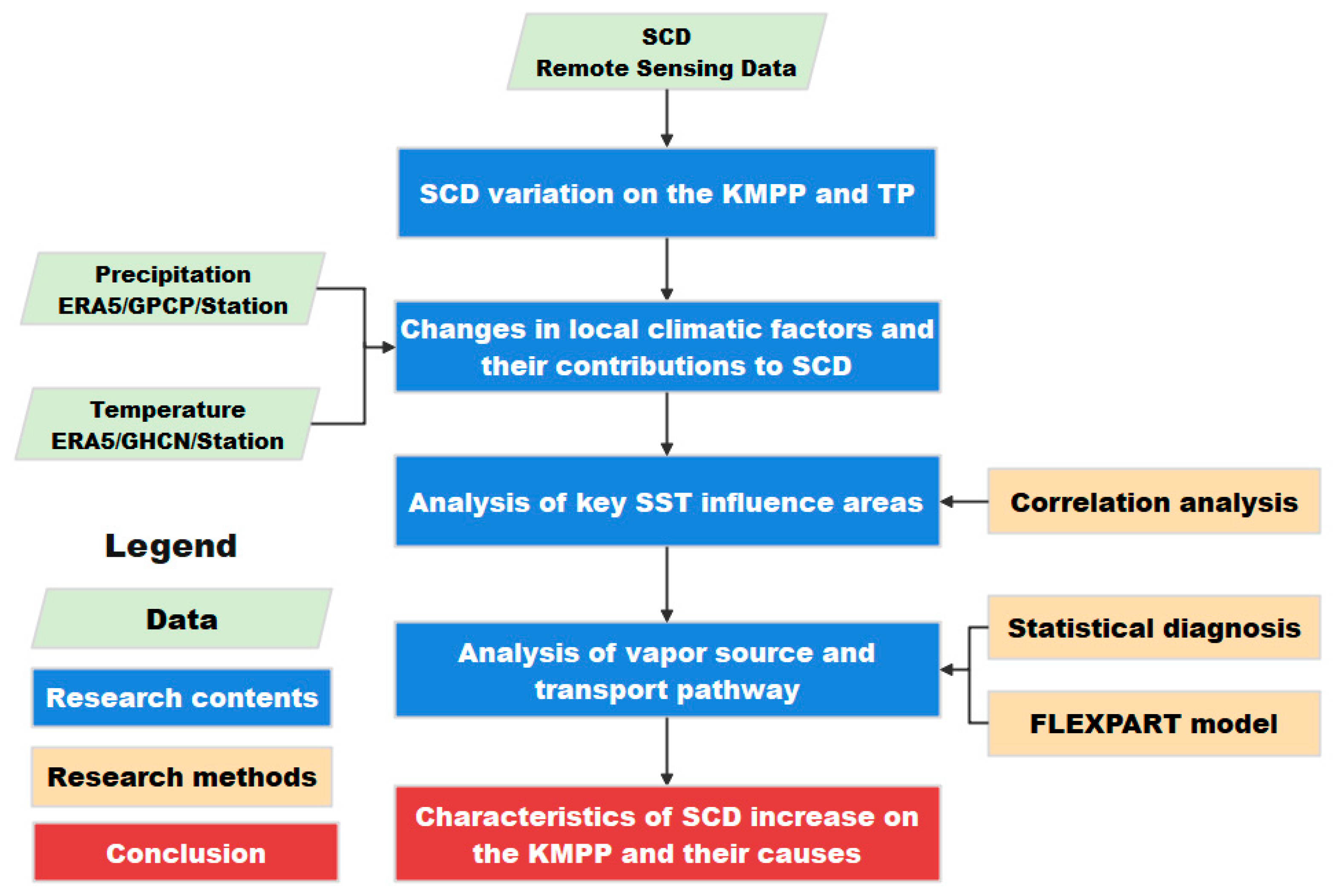

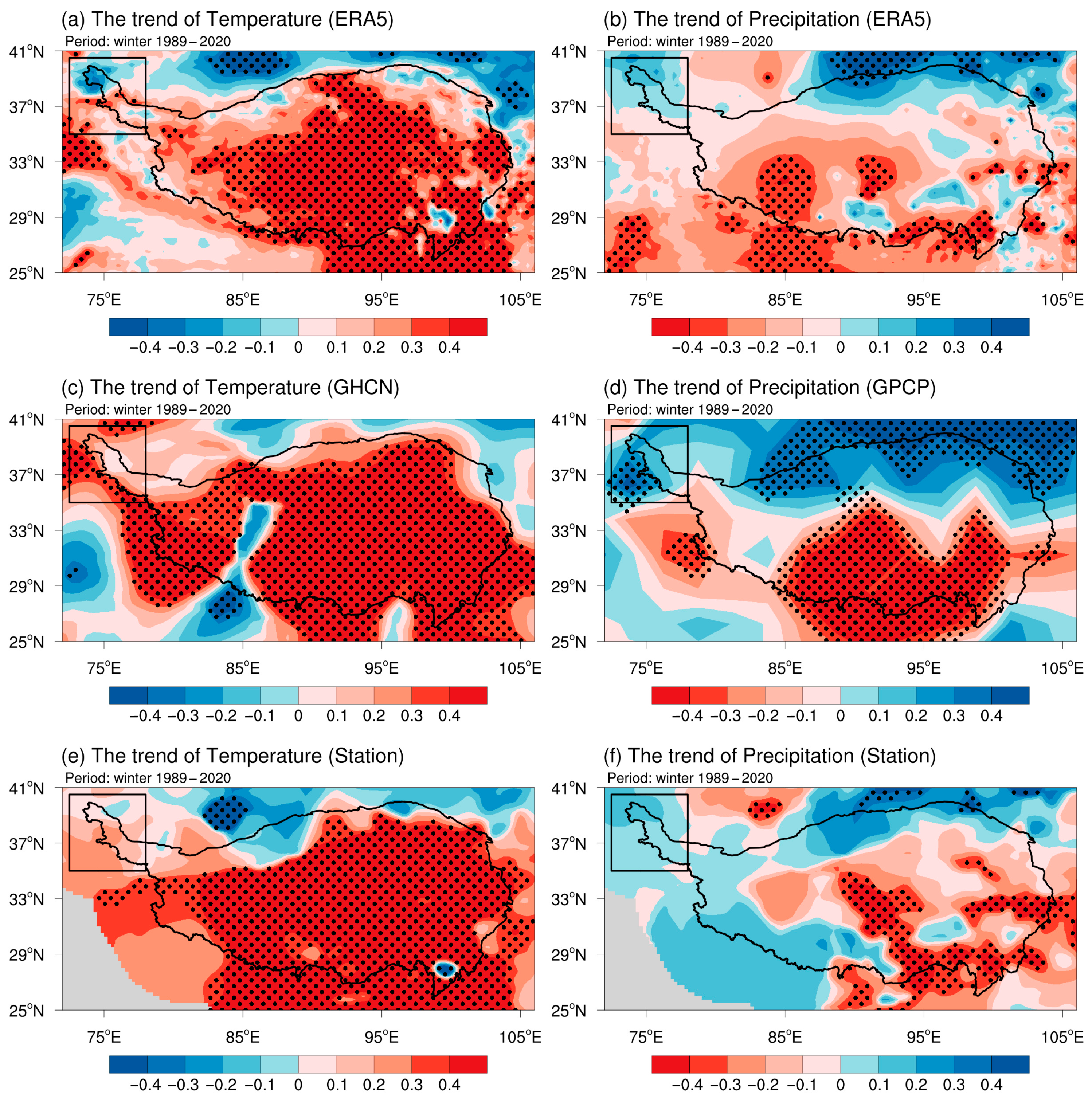

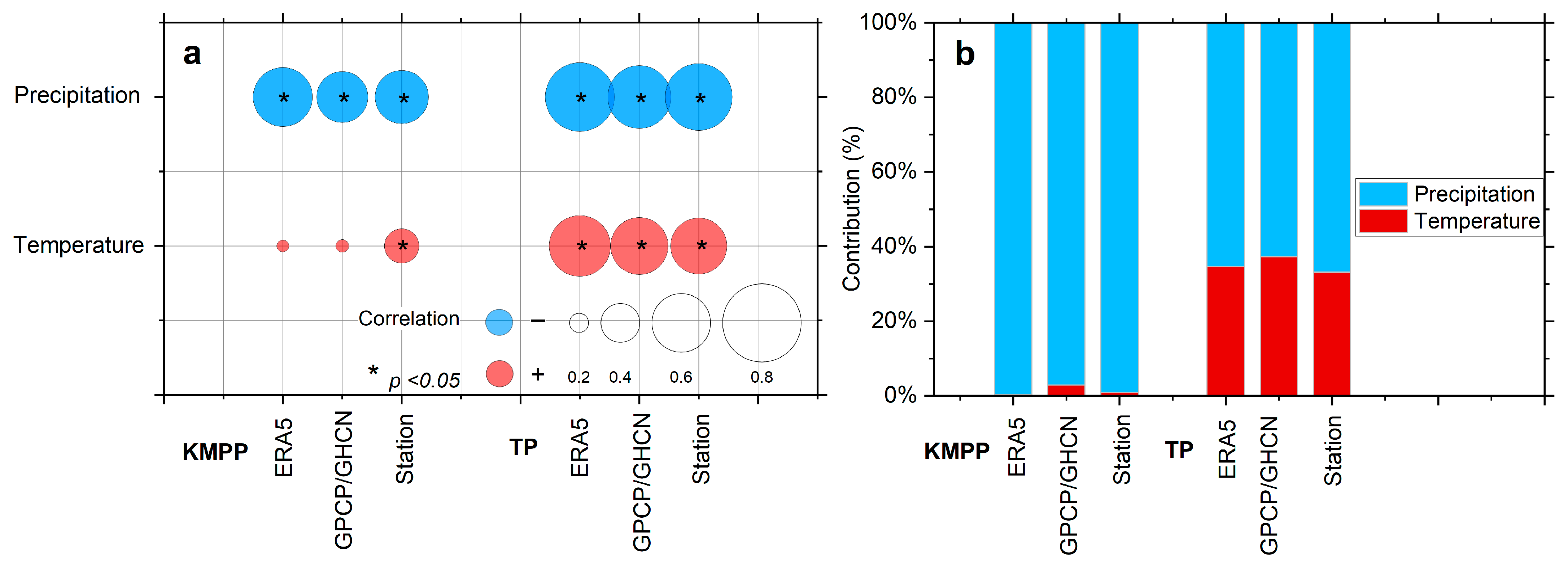

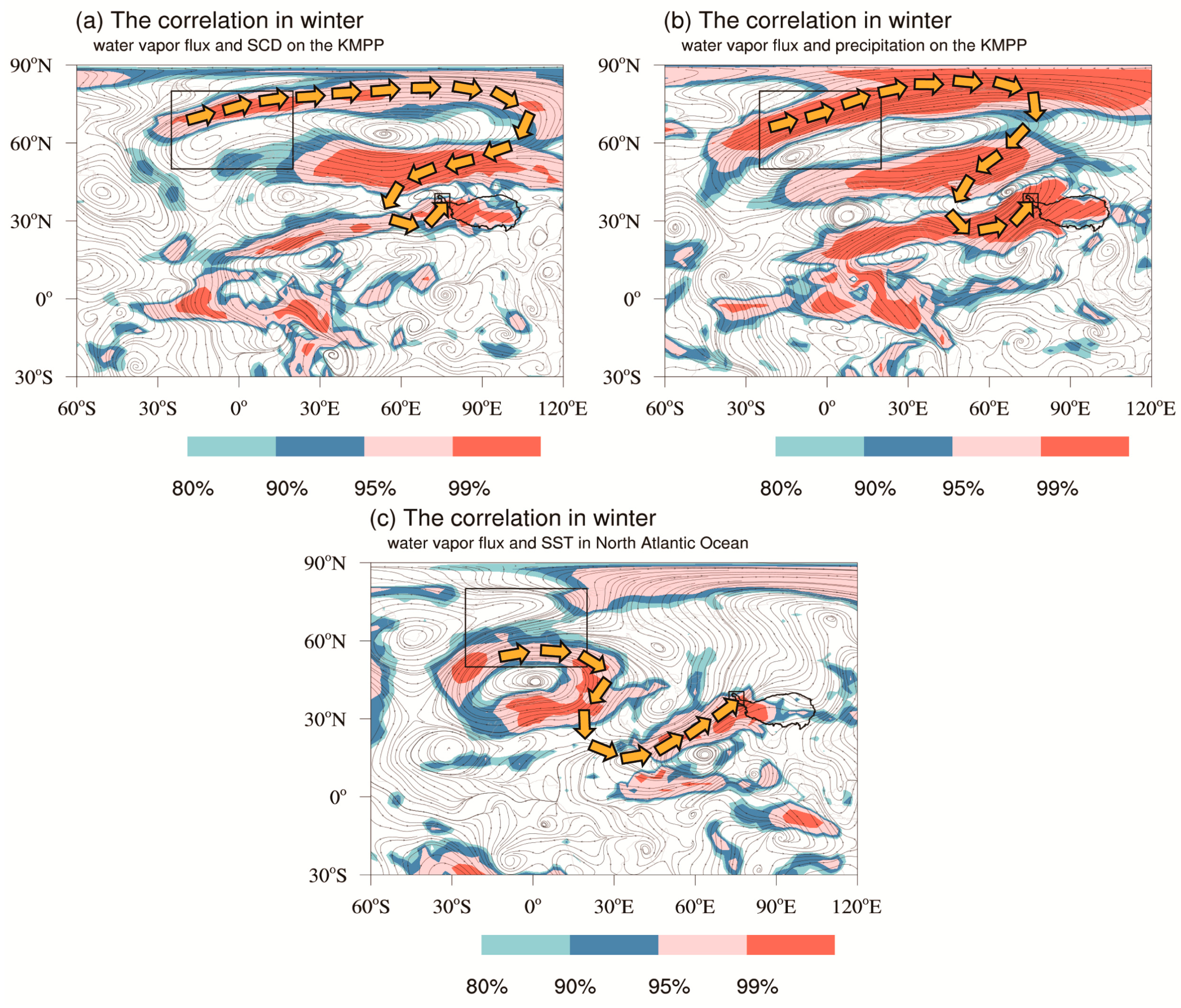
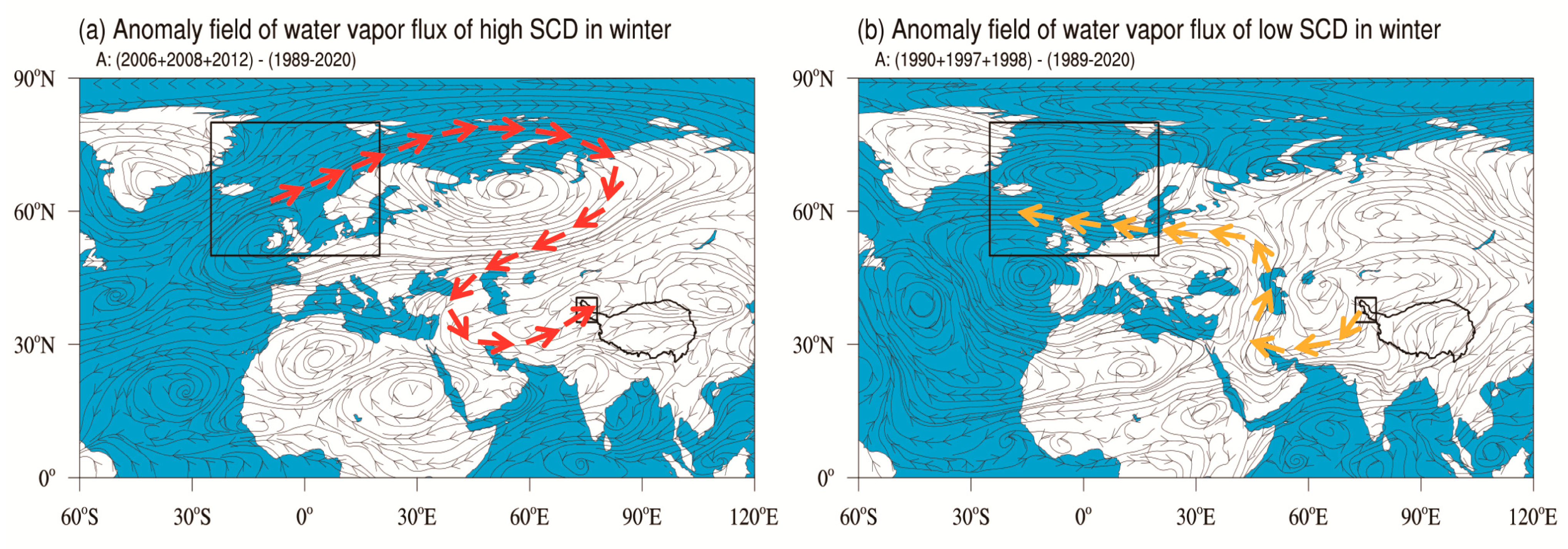
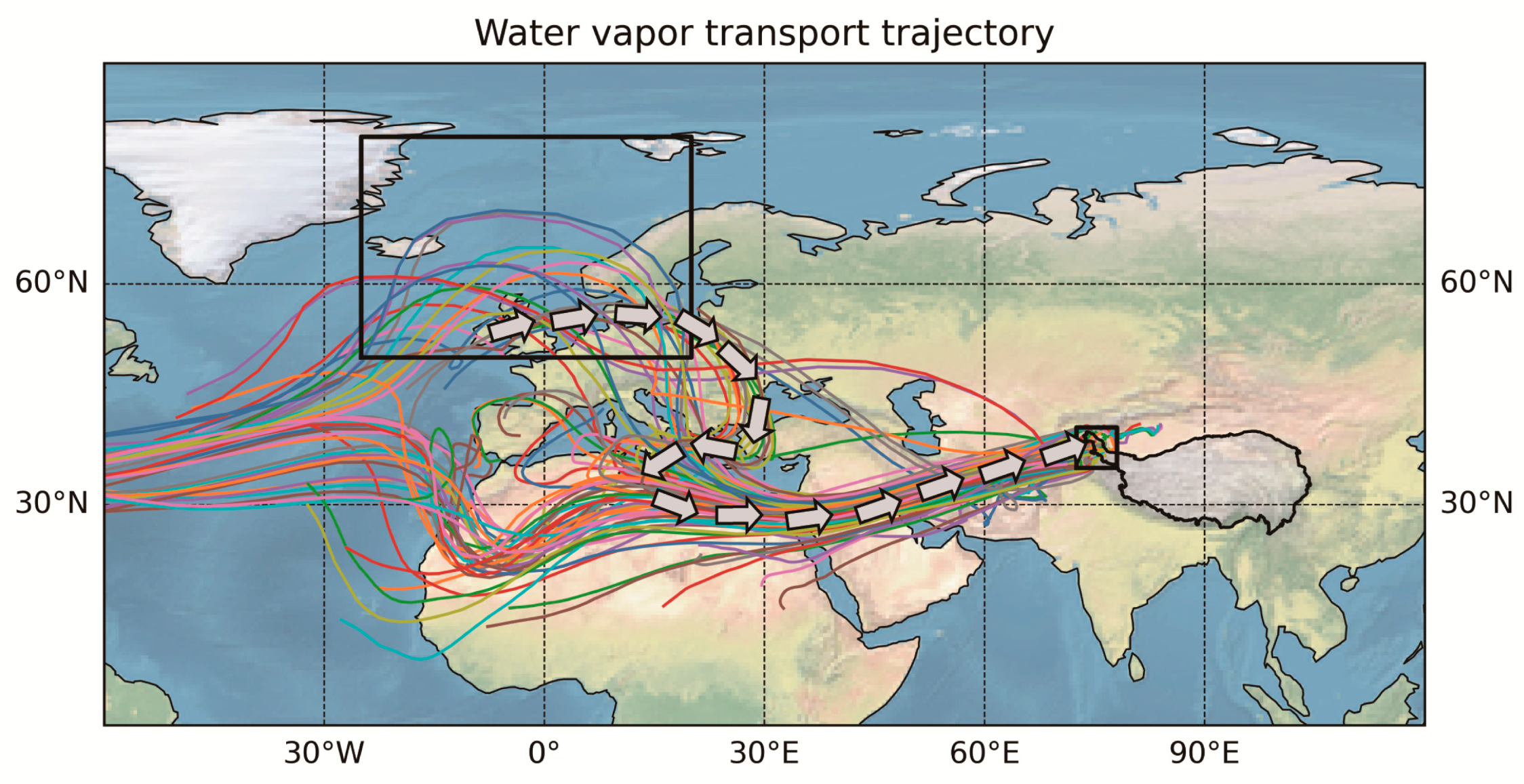
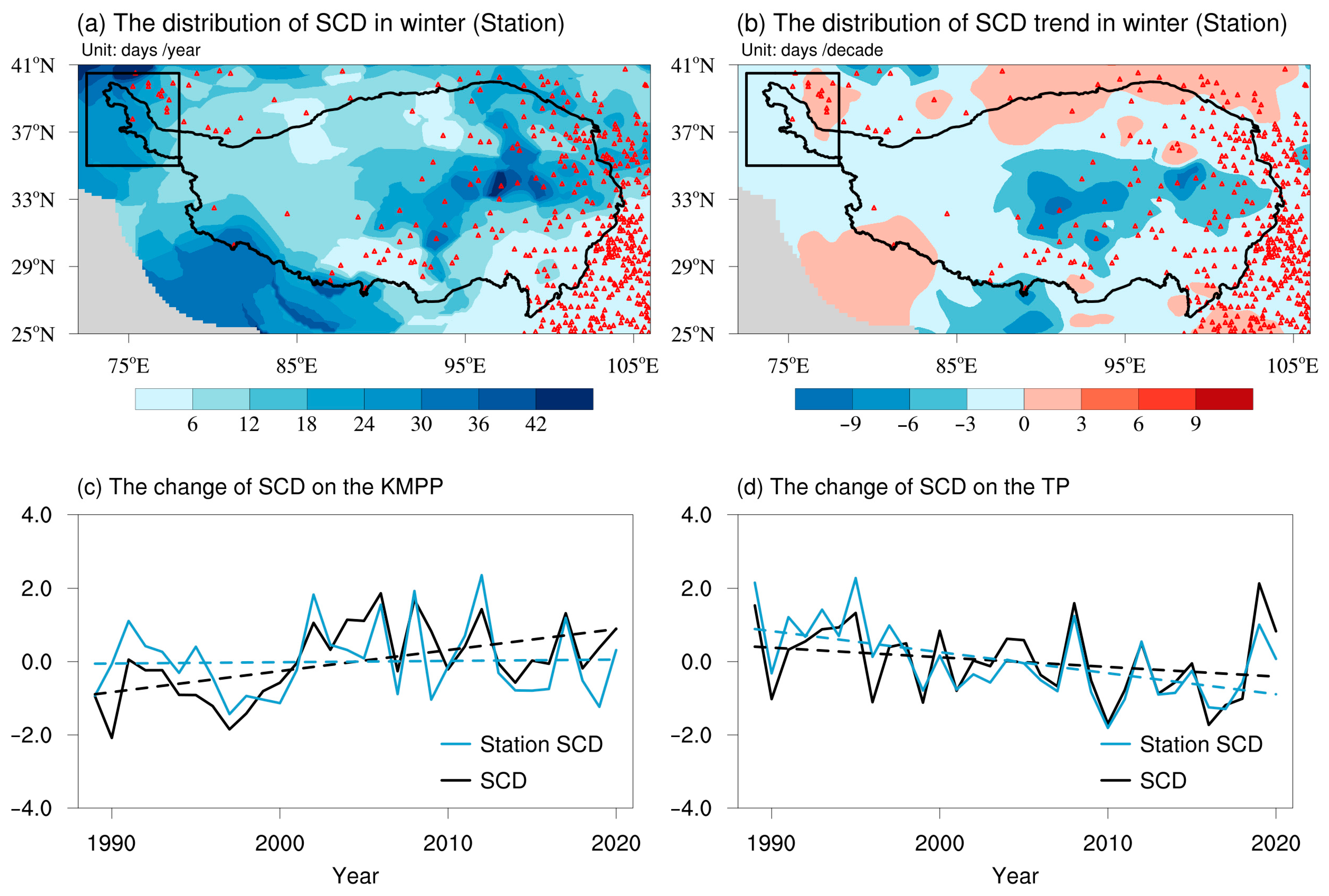
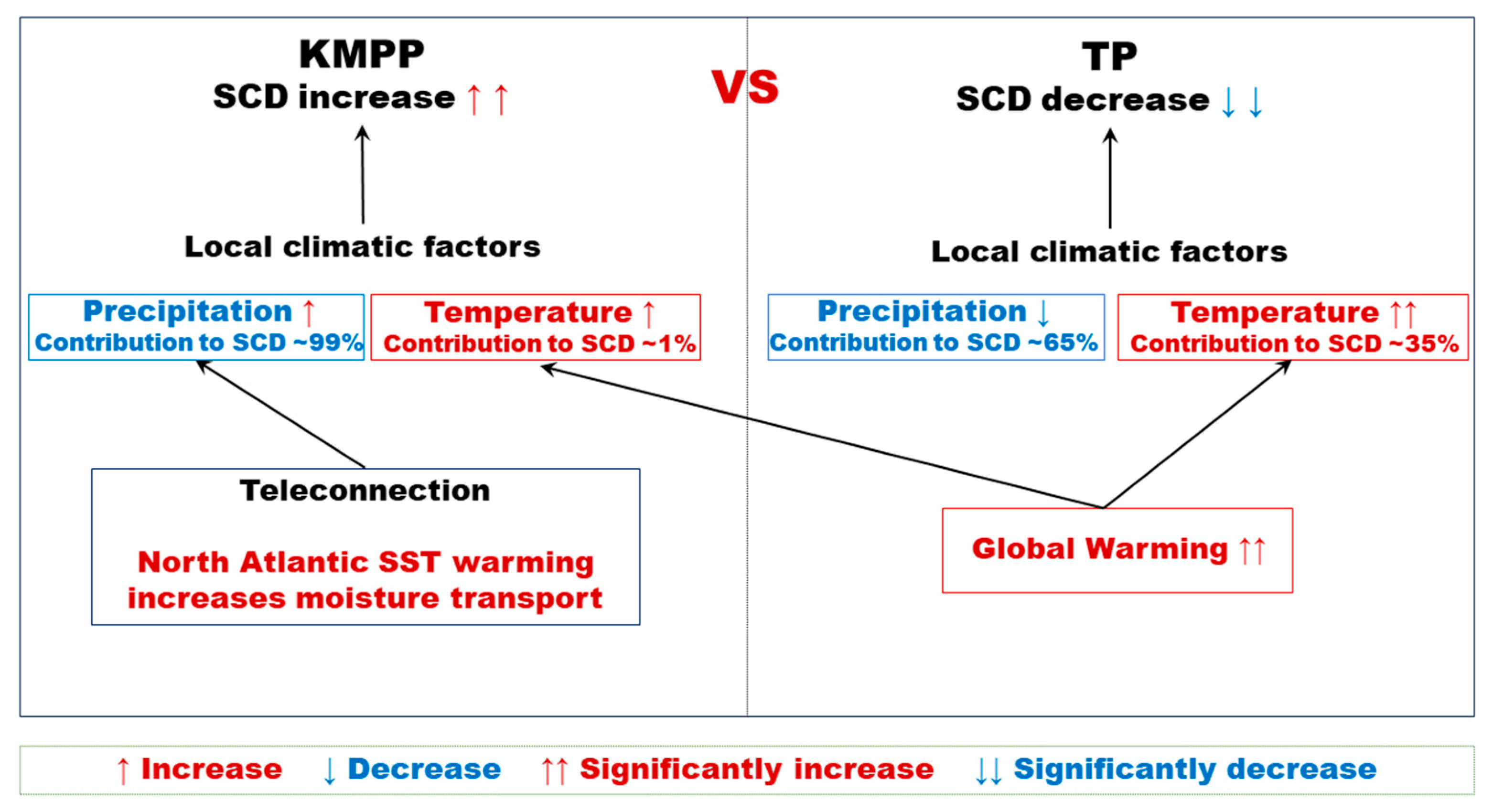
| Data Types | Data Names | Resolution | Data Sources |
|---|---|---|---|
| SCD Data | Remote sensing data | 0.1° × 0.1° | Xue et al. [17] |
| Station observation data | 133 Stations | National Meteorological Information Center, China Meteorological Administration (NMIC, CMA) | |
| Temperature | ERA5 reanalysis data | 0.25° × 0.25° | European Centre for Medium-Range Weather Forecasts (ECMWF) |
| Global Historical Climatology Network and the Climate Anomaly Monitoring System Gridded 2 m Temperature (Land) data (GHCN_CAMS) | 0.25° × 0.25° | National Oceanic and Atmospheric Administration (NOAA) | |
| Station observation data | 133 Stations | NMIC, CMA | |
| Precipitation | ERA5 reanalysis data | 0.25° × 0.25° | ECMWF |
| Global Precipitation Climatology Project data (GPCP) | 2.5° × 2.5° | NOAA | |
| Station observation data | 133 Stations | NMIC, CMA | |
| Sea surface temperature (SST) | Hadley Centre Sea Ice and Sea Surface Temperature data (HadISST) | 1° × 1° | Hadley Centre |
| Water vapor flux (u/v/q) | ERA5 reanalysis data | 0.25° × 0.25° | ECMWF |
| The FLEXPART model | Operational global analysis data | 1° × 1° | US National Center for Environmental Prediction (NCEP) |
| Region | Dataset | Period | Results | Reference |
|---|---|---|---|---|
| TP | Cloud-free SCD remote sensing data | 1980–2020 | TP decrease, Amu Darya basin increase | Huang et al. [7] |
| TP | Snow cover fraction from MODIS | 2001–2014 | Slightly decreased by about 1.1% | Li et al. [13] |
| TP | MODIS daily snow products and the Interactive Multi-sensor Snow and Ice Mapping System (IMS) | 2000–2015 | No widespread decline | Wang et al. [14] |
| TP | Snow cover fraction data of the Northern Hemisphere Snow Cover Version 4.1 | 1966–2016 | Large interannual variations in cold seasons | Wang et al. [30] |
| Eastern and central TP | 69 stations above 2000 m from CMA | 1961–2005 | Weakly positive | You et al. [43] |
| TP | NOAA Climate Data Record of SCD | 1985–2020 | Western TP decrease, eastern TP increase | Liu et al. [58] |
| TP | Snow cover fraction from MODIS | 2003–2010 | Decrease since 2003 | Wang et al. [60] |
| TP | Remote sensing SCD data | 1989–2020 | TP decrease, KMPP increase | This study |
Disclaimer/Publisher’s Note: The statements, opinions and data contained in all publications are solely those of the individual author(s) and contributor(s) and not of MDPI and/or the editor(s). MDPI and/or the editor(s) disclaim responsibility for any injury to people or property resulting from any ideas, methods, instructions or products referred to in the content. |
© 2024 by the authors. Licensee MDPI, Basel, Switzerland. This article is an open access article distributed under the terms and conditions of the Creative Commons Attribution (CC BY) license (https://creativecommons.org/licenses/by/4.0/).
Share and Cite
Xue, X.; Xu, X.; Ren, G.; Sun, X.; Zhang, P. The Influence of Local Climatic Factors and Water Vapor Transport from North Atlantic Ocean on Winter Snow-Cover Variation on Western Kunlun Mountains and Eastern Pamir Plateau. Remote Sens. 2024, 16, 4368. https://doi.org/10.3390/rs16234368
Xue X, Xu X, Ren G, Sun X, Zhang P. The Influence of Local Climatic Factors and Water Vapor Transport from North Atlantic Ocean on Winter Snow-Cover Variation on Western Kunlun Mountains and Eastern Pamir Plateau. Remote Sensing. 2024; 16(23):4368. https://doi.org/10.3390/rs16234368
Chicago/Turabian StyleXue, Xiaoying, Xiangde Xu, Guoyu Ren, Xiubao Sun, and Panfeng Zhang. 2024. "The Influence of Local Climatic Factors and Water Vapor Transport from North Atlantic Ocean on Winter Snow-Cover Variation on Western Kunlun Mountains and Eastern Pamir Plateau" Remote Sensing 16, no. 23: 4368. https://doi.org/10.3390/rs16234368
APA StyleXue, X., Xu, X., Ren, G., Sun, X., & Zhang, P. (2024). The Influence of Local Climatic Factors and Water Vapor Transport from North Atlantic Ocean on Winter Snow-Cover Variation on Western Kunlun Mountains and Eastern Pamir Plateau. Remote Sensing, 16(23), 4368. https://doi.org/10.3390/rs16234368







